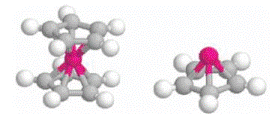Department of Physics and Astronomy: Publications and Other Research

Peter Dowben Publications
Document Type
Article
Date of this Version
May 1997
Abstract
We have grown nickel doped boron–carbon alloy films by the technique of plasma enhanced chemical vapor deposition. The source gas closo-1,2-dicarbadodecaborane (orthocarborane) was used to grow the boron–carbon alloy, while nickelocene [Ni(C5H5)2] was used as the dopant source for nickel. With sufficient levels of Ni doping, diodes with characteristic tunnel diode behavior can be fabricated. The doping of nickel transformed a B5C p-type material, relative to lightly doped n-type silicon, to a strongly n-type material. In order to gain insight into the shift of the Fermi level of the Ni-doped material, we have examined the changes in the electronic structure of sodium doped films of the precursor molecule orthocarborane which has an icosahedral structure similar to that of boron–carbon materials. The establishment of unoccupied states at the Fermi level with Na doping of the orthocarborane films is consistent with the transformation of the p-type B5C to an n-type material with Ni doping.


Comments
Published in the Journal of Vacuum Science and Technology A 15(3), May/Jun 1997. Copyright © 1997 American Vacuum Society. Used by permission. For free online abstracts, see http://www.avs.org/literature.jvst.b.aspx